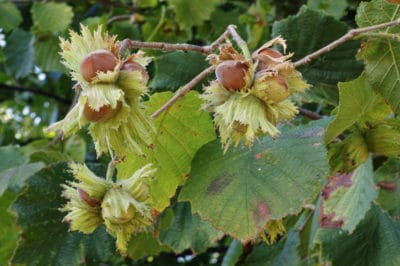The Right Growing Climate
Depending on variety, hazelnuts grow in USDA plant hardiness zones 3 through 8 or 9. American and beaked hazelnuts (Corylus americana, Corylus cornuta) handle cold better than European ones (Corylus avellana). The best hazelnut-growing climate, however, is in Oregon’s Willamette Valley. It features:
- Summers with highs averaging in the low 80s F (26° to 28°C) and lows in the low 50s F (10° to 12°C).
- Winters with highs averaging between 40° and 45°F (4.4° and 7.2°C) and lows between 30° and 34°F (-1.1° to 1.1°C).
- Plenty of rain from December through February, when about half of the Valley’s annual 30 to 40 inches falls.
Expert gardener’s tip: Hazelnuts can’t tolerate prolonged temperatures above 86°F (30°C) or extended dry periods.
Planting Site
Hazelnuts thrive in well draining but relatively poor soil. In fertile soil, they produce lots of leaves at the expense of flowers and nuts. They also need four or more hours of daily sun; more sun means a larger harvest.
Spacing
The most commonly grown hazelnuts are European/American hybrid trees standing 8 to 12 feet high and up to 12 feet wide. Plant two or more compatible varieties for cross pollination and space them 6 to 9 feet apart for an easier harvest.
Care After Planting
For their first two years, give hazelnuts ½ inch of water in any week of the growing season without rain. That equals 3 gallons per 10 square feet of soil. Water with a drip system if possible.
Conserve soil moisture with a 2- to 4-inch layer of organic material such as wood chips. Or plant enough trees, and eventually you can mulch with hazelnut shells!
Fertilizing
After the second year, test your soil annually for organic matter. If it’s less than 4.5 percent, dose the trees with a slow-release, 10-10-10 organic fertilizer once between May and August.
Pruning
Prune diseased, damaged or dead branches as they occur. Do maintenance pruning during the trees’ winter dormancy. Remove all the crossing limbs and — if the canopies are too dense — remove up to three of their upright central branches. Then cut back enough small older branches to let sunlight reach every part of each tree.
Expert gardener’s tip: Never prune the newest twigs where the female flowers and nuts form.
